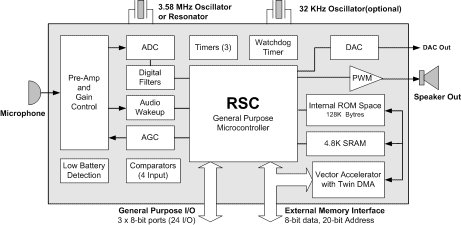
Sensory RSC-4128
Utilizzato nel modulo Voice (Sensory
RSC-4128 1MB Flash Simultaneous R/W )

FULL RANGE OF FLUENTCHIP™ CAPABILITIES
| ||||
| ||||
| ||||
| ||||
| ||||
| ||||
|
|
INTEGRATED SINGLE-CHIP SOLUTION
| ||
| ||
| ||
| ||
| ||
| ||
| ||
| ||
| ||
| ||
| ||
| ||
| ||
| ||
|
LONG BATTERY LIFE
| ||
| ||
|
The RSC-4128 is designed to support HMM (Hidden Markov Modeling) as well as Neural Network technologies provided in FluentChip™ firmware to perform speaker independent (SI) speech recognition. This requires onchip or off-chip ROM to store the words to be recognized. Speaker dependent (SD) recognition requires programmable memory to store personalized speech templates and may be on-chip SRAM or off-chip Serial EEPROM, Flash Memory, or SRAM. The RSC-4128 has several additional speech recognition features as described below:
Speaker Independent recognition requires no user training. The RSC-4128 can recognize up to 20 words in an active set (number of sets is limited only by internal ROM or external memory size). Text-to-SI (T2SI) recognition, based on HMM technology, allows creation of SI recognition sets in seconds. Speaker Dependent recognition allows the user to create names for products or customize vocabularies. Up to 100 words can be recognized in an active set (number of sets is limited only by internal ROM or external memory size). The RSC-4128 can store up to 10 SD words in on-chip SRAM. Continuous Listening allows the chip to continuously listen for a specific trigger word. With this feature, a product "activates" when a specific word is spoken, framed by quiet before and after. Continuous listening provides the lowest false fire rate for trigger words. Word Spotting allows the chip to continuously recognize for up to 10 SI or 5 SD words at a time. In word spotting mode, the word(s) to be recognized may be spoken in the middle of speech. Speaker Verification technology allows the RSC-4128 to be able to identify whether a particular word is spoken by the original speaker. Up to 10 SV templates can be stored on-chip, or more with external programmable memoryS
PEECH AND MUSIC SYNTHESIS The RSC-4128 provides high-quality speech synthesis using state of the art "SX" technolgy. Typical data rates are 6000 bits per second and require on-chip or off-chip ROM to store audio sound data. The RSC-4128 uses a MIDI-like system to generate high-quality, eight-voice, wave table music synthesis.R
ECORD AND PLAYBACK The RSC-4128 can perform speech record and playback (sometimes called "voice memo") at various compression levels depending on the quantity and quality of playback desired. The record and playback technology also performs silence removal to improve sound quality and reduce memory requirements.Ulteriore documentazione (in inglese) può essere trovata sul sito Sensory alla pagina RSC-4128
| Elenco revisioni | |
| 03-11-2005 | Prima emissione |